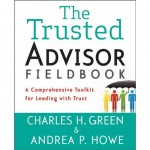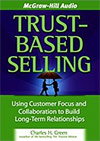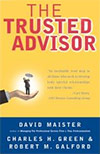The biggest difference between selling “things” and intangible services is the pivotal role of trust. Trust is even more critical to selling intangible services[1] than it is to selling things. Sellers of intangible services intuitively know this, but think that “selling” is destructive of trust. Many intangible services providers feel that selling is even unprofessional and unethical. Their professional lives are therefore fraught with contradiction. Not to mention they sell poorly!
All this angst and low performance comes about because intangible service providers believe a few myths. These myths comp partly from the world of selling “things,” and partly from projecting ideas about technical expertise onto clients. The myths seriously get in the way of developing business. Even more importantly, they keep providers from fully serving their clients—despite their best intentions.
Myth 1. It’s About Winning
Thinking in terms of “winning” leads insidiously to thinking in terms of winners and losers. Few providers consciously want to “beat” their clients—but they end up behaving that way! They talk about “share of wallet,” about bargaining or negotiating with their clients, about “controlling the agenda,” and about “managing expectations.” Each of these frames of reference sound innocent enough, but they rapidly degrade into a competitive perspective.
The world of selling things is full of zero-sum metaphors. Flight magazine ads say you’ll lose the sale to someone who can negotiate better. In technology businesses you’ll hear that only the paranoid survive. GE’s strategy was to be number 1 or number 2 in every business. The message in all these zero-sum pieces of wisdom is you’ve got to beat out someone else in order to win, and winning is everything. That works for selling things. But when it comes to selling intangible services, those insights pale before one other:
Choose your mantra and repeat frequently:
- “The only win worth winning is win-win”
- “The only way I win is if my client wins”
- “Winning a win-lose proposition is losing”
- “I will always and only do well by doing good”
- “If I focus on helping my client, it will always eventually pay off for us both.”
Myth 2. Selling is Unprofessional.
Take this three-part self-test. First—if you saw, with crystal clarity,
an opportunity outside your own area of expertise for a client to significantly improve her business—would you consider it a professional obligation to point it out to her?
Second: suppose that the opportunity you see so clearly isn’t imm
ediately
obvious to your client. Do you have a professional obligation to spend a little ti
me working out the best way
to communicate your insight, so your client can also see the opportunity?
Finally: suppose that the crystal-clear opportunity also happens to be within your area of expertise? Do you have a professional obligation to spend a little time working out the best way to communicate that value?
If you answered ‘yes’ to all three questions, then ask yourself one last question—what exactly is the difference between selling and what you just described? If you are honest with yourself and your client about the value of what you have to offer, then it is the essence of professionalism to aggressively and pointedly help the client see that value as well as you are privileged to see it.
There is of course one critical caveat in all the above. You do have to be right about the technical issue. Selling based on trust doesn’t mean you can avoid expertise; in fact, it means you have to assume it.
Myth 3. Clients Know What They Want.
They don’t. Particularly when they insist they do.
If clients knew what they wanted, they could (and they sometimes do) draft their own wills, design their own information systems, manage their own financial portfolios. But the daily stock in trade of an intangible services provider generally looks like a black art to the client. We all know the basics about cars and hamburgers, but not about probate or XTML or media buys.
Remember, clients are also victims of sales myths. They are afraid of being conned by salesmen, so they respond by tightly bounding the problem statement, to prevent being taken advantage of. The most fearful clients end up using RFP processes. Only the most self-confident clients admit that they themselves don’t fully understand the problem—which is precisely why they seek out experts. A well-defined problem makes the answer look easy. The real expertise and art lie in defining the problem.
Myth 4. Clients Mainly Want Experience and Credibility.
Most providers think that clients are focused on experience and credibility. No surprise there—most clients would say the same thing. But dig a little deeper.
Of course, clients use experience as a qualifier—to see who makes the short list to be invited in. They also use it as a justification to anyone who might question their choice. Clients also want to impress the provider with some level of knowledge, partly to guard against being taken advantage of. But those are all ways of narrowing the field or preventing harm. They don’t positively help assess trust.
Remember—clients don’t want to be experts in the provider’s field. If they did, they’d have gotten their own degree or certification. They also know they will need that expertise again in the future. What they would really love to have, if only they could be so fortunate, is confidence in an expert on whom they could then rely repeatedly. Clients don’t seek to trust their own expertise—they seek experts they can trust.
Most providers try to create trust by talking about their experience and credentials. Clients therefore assume that these are the important criteria to talk about. So most client/provider sales dialogues end up being a lot about experience and credibility. The implicit message is—“you can trust me because I’m telling you I did well by someone else who you don’t know, but who I’ll tell you about.” Which is why most buyers throw up their hands and focus on features and price.
The alternative is to establish real trust. Real trust gets established by working on this client’s issue, not the last client’s issue. Real trust comes from being demonstrated, not just talked about. Clients aren’t really interested in what you did for your last client; they want to know what you can do for them.
Clients’ main vehicle for assessing trust is your ability to address the issue facing them, head-on, with all its emotional complexities. The great news here is—you sell by doing. This is a samples business. You don’t sell intangibles by talking about them, but by demonstrating just what it feels like to work together.
The beauty of that is—it’s what you already do for a living anyway.
Myth 5. Just Do Good Work, the Business Will Come.
Providers wish that they could be judged on their merits, on the basis of the good work that they do. Hence one of the most pernicious myths about selling; the idea that “the best way to sell is just to do good work.”
This is not all wrong—certainly good work has a significant effect on a client’s predilection to buy more. And occasionally clients do in ask you to start work on the next project. But usually you have to take some action.
In the world of selling “things,” the admonition is usually “you’ve got to ask for the business.” But it’s different with intangible services. For intangible services, just “asking for the business” rarely works, particularly if your only qualification is good—even great—work on the last project. Great work on the last project just says you’re best qualified to do the next project. The real issue to be addressed is—just what is the next project?
If the client doesn’t see—viscerally, tangibly, emotionally—what the next project is, you can “ask for the business” all you want, but the client won’t see any business to be given. You won’t look like a hustler; but you will look out of touch with reality.
To sell the next project, you have to help the client see:
- that his or her business can be improved
- how it can be improved
- how you would go about improving it. Which you do by doing.
And as we saw while exploding Myth 2—that’s just part of your job as a professional. Focus not on your service offerings, but on what the client needs. Figure out how to deliver those needs. Start working.
Myth 6. Our Integrity is Constantly at Stake.
Stop making life so hard. Clients rarely challenge our integrity; we do that to ourselves by seeing things in terms of ego conflicts. There’s no need to engage on that level, and it usually just leads to conflict.
Do you find yourself muttering, “My client is a jerk?” Does your firm have a favorite story about the sale you walked away from rather than compromise your integrity? Are you constantly feeling pricing pressure or “scope creep” from your clients?
If so, you are caught up in a variation of Myth 1—the idea that our clients’ interests are at odds with our own. If there is an ego struggle with our client, then our client may or may not be in the wrong—but we definitely are. All those thoughts are simply variations of a failure to find common ground, a shared perspective. And if there is no common ground, there is no basis for win-win.
Differences of opinion are a fact of life. If we approach them calmly, we always have two choices—we can keep trying to find a common ground, or we can walk away. Sometimes it is right to walk away. But when that walk is colored with emotion, angst and a sense of moral righteousness, it’s rarely about integrity. It simply means we have let our ego get engaged. And ego engagement is self-focus, not client-focus. Give it up.
Myth 7. Being Right is Critical.
Most intangible services providers think and behave as if having the right answer is the critical element to the sale. It isn’t. Having the right answer is not even a necessary condition for getting a sale; it is far from being a sufficient condition.
How many times have you known with great certainty that your proposed solution to a client was the best one—highest value, least expensive, easiest to implement, best in the long term, and so on—and yet had the client reject it? It is tempting to impugn the client’s intelligence when this happens; but it simply indicates that you did not earn the right to offer a solution.
This doesn’t mean you can stop working at being right, or that it’s easy. You can’t, and it’s not. Intangible services are complex, requiring great study and continued diligence to stay on top of. Unfortunately, if you work hard and stay on top of things, all you have earned is the right to earn the right to be trusted. Your hard work won’t sell itself, nor even differentiate you from the many others who have worked equally hard and are (nearly) as expert as you.
Myth 8. Client Focus is a Matter of Process Design.
A fast food chain, an automobile company or a computer manufacturer may be able to engineer customer focus into its business processes. But for a provider of intangible services, customer focus is a self-willed psychological act. It is inescapably personal, human and individual.
It is tempting, particularly for large intangible services organizations like banks or accounting firms to borrow a page from the sellers of “things.” They can design processes to systematically track leads through stages in a funnel process, or bring CRM systems to bear. In the world of intangible services, these processes end up being places of refuge for people who are nervous about client contact. They end up filling out forms rather than meeting with clients. And since intangible services selling is so personal, that ends up being destructive rather than helping matters.
Clients buy on trust. A client knows in his or her tummy whether or not you are paying attention, whether or not you care about them, and whether or not you are truly listening to what they say. You can’t fake client focus. It’s personal. No CRM system in the world can overcome it.
Myth 9. It’s About Me.
It’s not. It’s about the client. Always.
It’s natural enough for a provider to feel the pressure personally. After all, the client very much is evaluating the trustworthiness, the personal characteristics, of the seller. But the client has his own fears; he doesn’t care about yours. Truth be told, he may be more afraid of you than you are of him.
You make it worse, not better, by obsessing about your tie, your PowerPoint slide deck, your rehearsed points, your litany of capabilities. Do not try to look smart. Do not worry about looking dumb, or wise, about solving the problem or controlling the agenda. Do not count the names you drop, the methodologies you explain, or the references you plan to mention. Come prepared to have all these things, but plan to use none of them. It’s not about you. It’s about the client.
What you think adds to your credibility usually either intimidates or bores the client—because it’s about you, not about the client. Limit yourself to 60-second answers, maximum, then turn it back to the client. Anything more is about you, not about the client. And it’s about the client. Always.
Myth 10. The Objective is to Get the Sale.
Revisit the mantras from Myth 1. The point is not to get the sale—the point is to help the client. If you help the client, you’ll probably get the sale. If you don’t get this sale, you’ll probably get the next one. If you don’t get that one, you’ll get another. If you don’t get that one, write it off, and return to step one—help the client. If you consistently do that, word will get around. Because that kind of caring is rare, and highly prized by clients.
Bonus Myth 11. Leads are Scarce.
In the world of selling things, leads are scarce. Airlines, hotels, automobile companies all fight fiercely for share points—with good reason. There are only so many airline flights that will be made; so many hotel rooms that will be booked; and so many automobiles that will be bought.
There are fewer boundaries in the intangible services. Every client is miles from perfection on dozens of dimensions. Each could have better marketing strategies, more customized systems, more effective customer service or fulfillment processes.
In other words, every existing client is brimming with potential leads. Yet many intangibles firms spend huge amounts of resources on leads, making three mistakes:
- Focusing too much on new clients they don’t know, instead of on existing clients
- Talking with each other about potential client needs rather than with the client
- Focusing on service offerings rather than on client needs.
Firms do this for various reasons, but chief among them is that they are focused on themselves, not on the client. They have forgotten the truth that:
If given the choice, buyers of intangible services greatly prefer to buy the things they need from someone they trust.[2]
If you help your client explore solutions—to all their problems, including solutions you yourself can’t provide—you’ll get your share of sales. Does that mean lawyers should point out systems needs? Yes, if they’re real and you can see them. Does that mean you should refer your client to a competitor? Yes, if the competitor can address a particular need better than you can. Stop worrying about yourself; serve the client.
Leads are not scarce—they are a commodity. What is scarce is imagination and generosity. Imagination to see the potential in alternative realities. Generosity to give of our attention to help focus on making our clients’ lives better, believing simply that if we do so, we too will prosper.
1. Intangible services include: the professions—law, accounting, consulting, advertising and PR; HR, internal consultants and staff functions like law and accounting; many financial services—private banking, financial advising, insurance, and brokerage; B2B software—ERP and CRM systems and databases; and various out-sourced corporate functions like call centers, telecom/computer service contracts, benefits administration, and real property management. (return to top)
2. Credit for a variation on this insight goes to Bill Brooks and Tom Travesano, You’re Working Too Hard to Make the Sale, McGraw Hill, 1995.
Talk To Us
THE TRUSTED ADVISOR FIELDBOOK
 The pragmatic, field-oriented follow-on to the classic The Trusted Advisor. Green and Howe go deep into the how-to’s of trusted business relationships—loaded with stories, exercises, tips and tricks, and deeply practical advice.
The pragmatic, field-oriented follow-on to the classic The Trusted Advisor. Green and Howe go deep into the how-to’s of trusted business relationships—loaded with stories, exercises, tips and tricks, and deeply practical advice.
FIND OUT MORE
TRUST-BASED SELLING
 “Sales” and “Trust” rarely inhabit the same sentence. Customers fear being “sold” — they suspect sellers have only their own interests at heart. Is this a built-in conflict? Or can sellers serve buyers’ interests and their own as well? The solution is simple to state, hard to live—and totally worth the effort.
“Sales” and “Trust” rarely inhabit the same sentence. Customers fear being “sold” — they suspect sellers have only their own interests at heart. Is this a built-in conflict? Or can sellers serve buyers’ interests and their own as well? The solution is simple to state, hard to live—and totally worth the effort.



